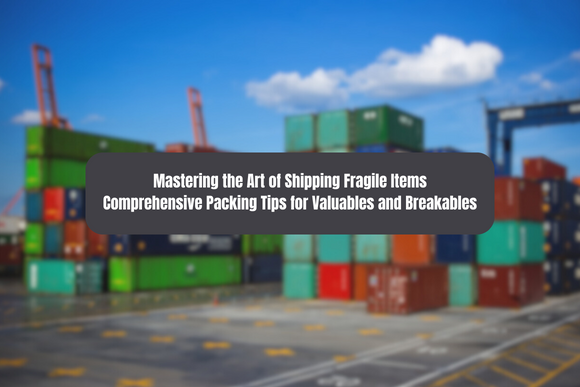Introduction:
Shipping fragile items demands a meticulous approach to packaging to ensure the safe arrival of your valuable possessions. Whether you’re moving homes, sending gifts, or relocating delicate personal effects internationally, mastering the art of packing is crucial. In this extensive blog post, we’ll delve into a comprehensive guide, offering valuable insights and practical tips to safeguard your breakables during transit.
- Understanding the Fragility of Your Items : Before embarking on the packing process, take stock of the fragility of your items. Identify the materials, shapes, and sizes, as this knowledge will inform your choice of packaging materials and techniques.
- Selecting the Right Packaging Materials : Choosing the appropriate packaging materials is the foundation of secure shipping. Discuss the importance of materials such as bubble wrap, packing peanuts, foam sheets, and sturdy double-walled boxes. Highlight the significance of investing in high-quality materials to withstand the rigors of transportation.
- Effective Sealing and Reinforcement Techniques : Properly sealing and reinforcing boxes is a crucial step in preventing damage. Guide readers on using strong tape, reinforcing corners, and clearly labeling boxes as fragile. Emphasize the role of a well-sealed box in protecting items from external elements.
- Individual Wrapping Techniques : Explore various techniques for wrapping fragile items individually. Discuss the use of tissue paper, cardboard dividers, and custom crates for added protection. Illustrate how these methods safeguard items from scratches and breakage during transit.
- Strategic Packing Approaches : Provide readers with a step-by-step guide on how to pack with precision. Discuss placing the heaviest items at the bottom, filling empty spaces, and implementing a layering technique. Emphasize the importance of stability and minimizing movement within the box.
- Special Considerations for Highly Fragile Items : For exceptionally delicate items, delve into special considerations. Discuss the benefits of custom-built wooden crates, additional layers of protection, and insurance options. Addressing these concerns will assure readers that every precaution is taken for their most fragile possessions.
- International Shipping Tips : If applicable, offer insights into shipping fragile items internationally. Discuss potential challenges such as longer transit times, customs procedures, and varying environmental conditions. Provide tips on additional documentation and labeling for international shipments.
- Post-Shipping Inspection and Care : Conclude the guide by highlighting the importance of post-shipping inspection. Encourage recipients to carefully inspect their items upon arrival, documenting any damage immediately. Offer advice on reaching out to the shipping provider for resolution if needed.
- Climate Considerations for Fragile Items : Discuss the impact of climate on fragile items during transportation. Highlight the importance of considering temperature and humidity variations, especially for items susceptible to environmental changes. Recommend additional protective measures such as moisture-absorbing packets or climate-controlled shipping options.
- Customization for Unique Items : Acknowledge that not all fragile items are created equal. Some may have unique shapes or materials that require special attention. Offer customization tips for irregularly shaped items, emphasizing the need for tailored solutions to ensure maximum protection during shipping.
- DIY vs. Professional Packing Services : Delve into the pros and cons of DIY ( Do It Yourself) packing versus hiring professional packing services. Discuss when it makes sense to enlist the help of experts, especially for high-value or particularly delicate items. Highlight instances where professionals can provide additional insurance or guarantees for safe delivery.
- Communication with Shipping Providers : Stress the importance of clear communication with shipping providers. Encourage readers to discuss the fragility of their items with the shipping company, providing any necessary instructions or precautions. Effective communication can ensure that carriers handle packages with the necessary care.
- Cost-Effective Packaging Solutions : Recognize that shipping costs can add up, especially when considering fragile items. Offer cost-effective packaging solutions and alternatives that still provide adequate protection. Discuss bulk purchasing options, eco-friendly materials, and DIY packaging ideas that won’t compromise on safety.
- Educating Recipients for Safe Unpacking : Extend the focus beyond shipping and provide guidance on safe unpacking. Offer recipients tips on carefully opening packages, handling fragile items, and properly disposing of packaging materials. This ensures the protection of items even after they reach their destination.
- Technology and Fragile Items : Explore how technology can aid in shipping fragile items. Discuss the use of tracking systems, smart packaging solutions, and temperature monitoring devices. Highlight how embracing technology can provide both shippers and recipients with real-time information and peace of mind.
Conclusion:
Mastering the art of shipping fragile items is a multifaceted endeavor that goes beyond just packing techniques. By considering climate, customization, professional services, communication, cost-effective solutions, recipient education, and technology integration, individuals can approach the shipping process with a holistic mindset. This comprehensive guide aims to empower readers with the knowledge and strategies needed to navigate the intricacies of shipping delicate and valuable items successfully.



